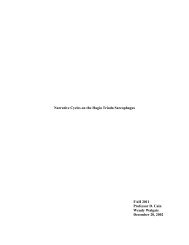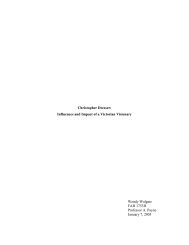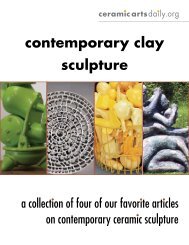Create successful ePaper yourself
Turn your PDF publications into a flip-book with our unique Google optimized e-Paper software.
Architectural drawings of classical Greek temples, Baroque and Rococo cathedrals held<br />
clues to building systems that could be used to support my work. Another exquisite<br />
source was the 18th century architect, Piranesi, who etched and drew architectural<br />
fantasies and settings that my work would fit into perfectly. On my studio wall is a<br />
photocopy of a particularly classic Piranesi scene with columns, statues and stairways<br />
and I look on it as my window to a world that I can enter.<br />
Other origins of form included the Cranbrook landscape and building design that I have<br />
been immersed in for two years. Being fortunate enough to be able to walk through the<br />
Cranbrook gardens on my way to the studio, I know that the fountains, statues, decorative<br />
brickwork and Cranbrook sense of grandeur have all made a strong impression on my<br />
work.<br />
Silverwork of the 18th century consists of ornate, but inventive structural forms. In<br />
particular, the extremely tall, covered altar cups gave me inspiration for my domed place<br />
settings. Although metalwork doesn't have to contend with gravity as in claywork, and<br />
the soaring forms are more realistically achieved.<br />
Piranesi, Early Architectural Fantasies, Andrew Robison (Pg. 15):<br />
In general, Piranesi has refined the ...busy complexity of<br />
architecture and interior ornamentation to focus attention instead<br />
on the grand masses of architectural structures. He has eliminated<br />
elaborate baroque shellwork, strapwork and curls and replaced<br />
them with more consistently classical statues and ornaments.<br />
While Piranesi does continue the tradition of rich surface<br />
decoration, he reduces ... the profuse ornamentation, which<br />
interrupts the lines of a building, retaining only ornaments<br />
adapted to rather than obscuring the basic lines and divisions of<br />
the architectural forms. This focus on structure also enables<br />
Piranesi to portray the massiveness of individual forms more<br />
convincingly, to enlarge the number and scale of forms while<br />
maintaining structural clarity, and to create an even more<br />
palpable and enormous space . . .<br />
Structure and form were explored in a number of ways in my work this year. I used the<br />
interiors of found containers, the shapes achieved from pressing into a piece of wood<br />
corner moulding and plastic jelly moulds to produce clay forms. All sorts of objects can<br />
be lined with dry cleaning plastic or dusted with cornstarch to help release the clay. Then<br />
I stack these three-dimensional forms in different ways; cut them into sections, join parts<br />
together and take them apart, until the arrangement becomes visually exciting and<br />
basically stable.<br />
Just a note on precariousness. When I started building separate bases and tall lids, for my<br />
22





